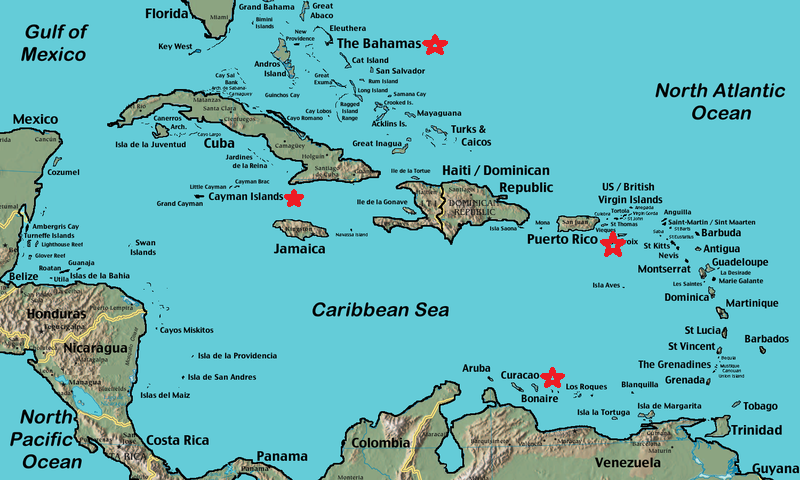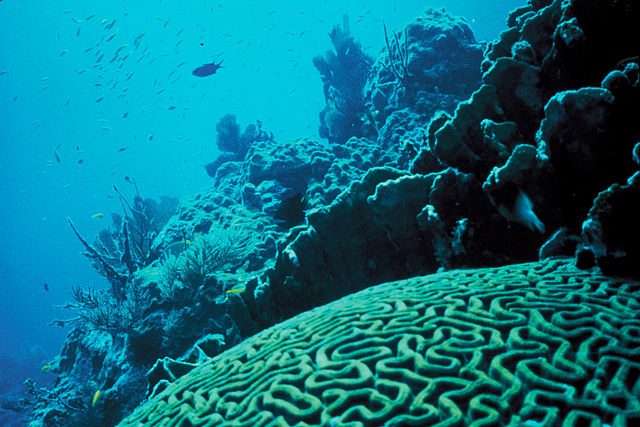Habitat
Fish in the family of Anomalopidae, can be found in the
benthic zones of the southern hemisphere and off the coasts of coral reefs. Kryptophanaron
alfredi can be found in several locations in the
Caribbean. One study located the fish near Puerto
Rico and Parguera (Haygood et al. 1984). Another study
found the fish around the Grand Cayman Island (Colin et
al. 1979). Other organisms that share the same
benthic zone habitat include:
Odontosyllis phosphorea and
Ophiopsila riisei. This fish lives in the Caribbean
because the waters contain the most optimal temperatures
for its mutualistic symbiosis with the luminescent
bacteria. The bacteria are housed in a light organ
which is used for mating and searching for food off the
rocks and coral on the reef (Colin et al. 1979).
For more information on the light organ, refer to the
adapation page.

Figure 1. Map of Caribbean where Kryptophanaron
alfredi inhabits. (Modified by Lynzee Pinkert,
2013).
The fish of the family Anomalopidae, live in deep waters
during the day but surface around 10m-40m at night off
the banks of reefs. They use the tactic of
staying in deep water during the day to avoid predators
and surface at night to search for food. According
to one study, it could be hypothesized that the fish
surface only long enough to fill their stomachs and
return to the deep waters to avoid predators and divers.
The Kryptophanaron alfredi eats small aquatic
crustaceans like shrimp, copepods and other small
fishes. This study captured fish and found 45 shrimps
packed in one of the stomachs of fish collected in the
Grand Cayman (Colin et al. 1979).
Another hypothesis why the fish surface at night can be
accounted for by the moon. As stated before, the
fish only surface during the night. Interestingly,
the length and timing of the surfacing could be
influenced by the moon (Colin et al. 1979). One
study done in the Cayman Islands found the number of
fish that rose to the surface decreased when the moon
was blocked by clouds. Kryptophanaron alfredi
is sensitive to the moon’s strong illumination (Colin et
al. 1979).

Figure 2. Coral reef.
Jerry Reid. U.S. Fish and Wildlife Service.
The best suited environment for the Kryptophanaron
alfredi is a habitat that contains both shallow and
deep waters. The fish need shallow waters to feed
and to allow their larva to be dispersed throughout the
water columns (Baldwin & Johnson 1995). They need
deep waters for their own protection, but also for the
protection of their eggs. (To learn more about
their egg and larva, visit the
reproduction page.) K. alfredi can
be found in deep waters that contain many rocks,
crevices, and caves. One study of the Cayman
Island specimen found their environment to be
“characterized by deep erosion channels, undercut
ledges, and numerous caves” (Colin et al. 1979).
It is important for their environment to contain these
structures for the protection of their young. The
eggs attach to the rocks and caves and are protected
from being eaten by predators. Another organism
that uses caves and crevices in their environment for
protection is the
Enteroctopus megalocyathus (Patagonian red
octopus).
Want to keep reading? Visit our Adaptation page.
Return to home.